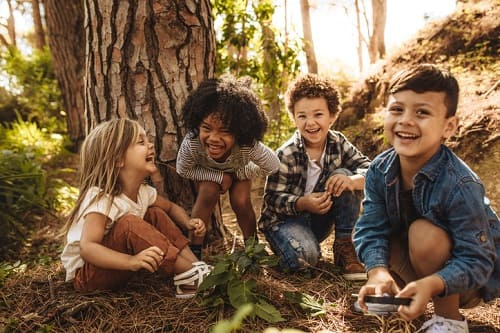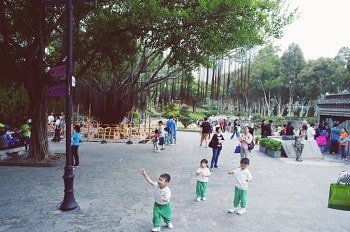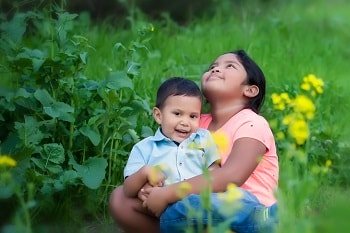
Does your child feel connected with nature? Researchers can measure these feelings with a standard questionnaire, and they’ve discovered fascinating links. Nature-loving children are happier. They experience fewer behavior problems. And they are more likely to treat others with kindness.
What happens when we spend time outdoors in natural spaces? Good things!
Studies suggest that nature experiences can defuse toxic stress and promote good health. They can improve our moods and renew our ability to concentrate. They might even protect us from developing psychiatric problems. (Read more about it in this Parenting Science article.)
But are the effects the same for everyone? Maybe not. After all, people have different attitudes about nature. Some feel an emotional or spiritual connection with nature. Others don’t. Do these feelings make a difference to our well-being? It looks that way.
Feeling connected to nature is linked with better emotional outcomes
For example, researchers in Canada asked 30,000 adolescents if they were experiencing emotional problems or symptoms of stress (Piccininni et al 2018). The kids answered questions about irritability, nervousness, depression, sleep disturbance, and frequent headaches. In addition, the kids rated their feelings about the natural world. And researchers discovered a telling link:
Compared with kids who were relatively indifferent, adolescents who rated their connection with nature as “important” had a 25% reduction in stress-related symptoms.
In a smaller study of approximately 300 primary school children in Mexico, researchers found that kids with strong feelings of connectness to nature tended to report higher levels of happiness (Barrera-Hernandez et al 2020).
And parallel results have been reported in a wide range of adult surveys. Across 30 published studies on adult well-being, connectedness to nature has been linked with greater feelings of happiness and vitality (Capaldi et al 2015). In a meta-analysis of 20 different studies, nature connectedness was linked with higher levels of personal growth (Pritchard et al 2020).
Not surprisingly, connectedness to nature has also been linked with greater feelings of responsibility toward the environment.
Adults who feel connected to nature take more actions to protect and preserve it (Geng et al 2015), and it’s likely that kids experience a similar effect.
In that survey of Mexican children, feelings of connectedness to nature were strongly correlated with pro-ecological behavior (like conserving household resources).
Another survey — conducted on more than 2,000 primary school students in China — reported similar results (Yue and Chen 2023). This was true even for city kids who didn’t have much direct experience with nature. Despite their urban surroundings, they maintained feelings of connectedness through nature-related activities — like visiting zoos, museums and aquariums, and watching nature documentaries.
And in a Swedish study, researchers found that 10-year-old children developed stronger feelings of responsibility and care toward wildlife after they helped rescue a local amphibian species from a human-made hazard. Two years later, these kids still reported feeling increased sympathy and concern for the creatures (Barthel et al 2018).
But there is likely much more. Kids who love nature aren’t just happier and more invested in protecting the environment. They also seem to be better-behaved — and more caring — towards their fellow human beings.
Evidence: Young children who feel connected to nature are more prosocial, and less likely to clash with other people

Consider this study by Tanja Sobko and her colleagues — a study of families living in Hong Kong. Hong Kong is intensely urban, but it’s dotted by many parks and green spaces. In fact, 90% of the population lives within 400 meters of one of these small “nature zones.”
So there are many opportunities for outdoor activities and nature experiences. Does nature play an important role in children’s lives? And, if so, does a child’s feelings about nature predict his or her behavior toward other human beings?
To answer, Sobko and colleagues recruited more than 200 parents of young children — kids between the ages of 2 and 5. And the researchers asked parents to fill out two different questionnaires.
One was a standard screening tool called the “Strengths and Difficulties Questionnaire.” It measures behavioral and emotional adjustment. Parents were asked if their children experienced
- conduct problems (like fighting or cheating)
- peer problems (like peer rejection, or a lack of friends)
- emotional problems (like frequent fears, or angry outbursts), and
- attention problems (like difficulty staying focused and completing tasks).
In addition, parents were asked to assess the degree to which their youngsters behaved prosocially, i.e., whether their kids were
- considerate of other people’s feelings
- helpful if another child is hurt, upset, or feeling ill
- kind to others; and
- ready to share with other kids.
The second questionnaire, called the “Connectedness to Nature Index for Parents of Preschool Children,” or CNI-PPC, asked parents to rate their agreement with statements about their children’s
- enjoyment of nature,
- empathy for nature,
- responsibility for nature, and
- awareness of nature.
For example, parents read statements like “Being in nature makes my child peaceful” (a measure of “enjoyment of nature”), and they indicated whether the statements were true, only somewhat true, or not at all true.
I’ve copied some additional sample items below. They will help you better understand what the researchers were looking for. They also offer some thought-provoking questions for you to ask about your own child.
Does your child feel connected to nature?
Sample items from the Connectedness to Nature Index for Parents of Preschool Children
Ask yourself, are these statements true, only somewhat true, or not at all true?
ENJOYMENT OF NATURE:
- My child likes to hear different sounds in nature.
- My child likes to see wild flowers in nature.
- My child likes to garden and plant.
- My child enjoys collecting rocks and plants.
EMPATHY FOR NATURE:
- My child feels sad when wild animals are hurt.
- My child is distressed when he or she sees animals being hurt.
- My child is heartbroken when animals pass away.
RESPONSIBILITY FOR NATURE:
- My child believes that picking up trash can help nature.
- My child treats plants, animals, and insects with care.
- My child enjoys recycling paper and bottles.
AWARENESS OF NATURE:
- My child notices wildlife wherever he or she is.
- My child notices birds and other sounds in nature.
- My child chooses to read about plants and animals.
So what were the results of the study? What did the researchers discover?
Three of the “connectedness” factors — enjoyment of nature, responsibility for nature, and awareness of nature — were directly related to preschoolers’ behavior, and some of the effects were large.
For instance, responsibility toward nature explained about 70% of the variation in conduct problems and prosocial behavior. It explained approximately 60% of the variation in peer problems, and 40% of the variation in children’s tendencies to be hyperactive or inattentive.
Enjoyment of nature had a widespread impact across the spectrum of social and emotional functioning, explaining about 50% of the variation among children.
And awareness of nature explained approximately 50% of the observed variation in children’s emotional problems.
What about empathy for nature? That, too, was strongly linked to social and behavioral problems, but the path was indirect. Children who scored high on empathy for nature tended to score high on responsibility toward nature, and it was responsibility– a factor emphasizing a child’s actions — that best predicted a child’s behavior and social-emotional status.
What explains these links?
Why was connectedness to nature linked with better child outcomes?
The researchers caution that they didn’t collect information on the parents’ socioeconomic status and parenting styles. They didn’t ask parents about their own, personal attitudes toward nature.
And it’s sure bet that parental characteristics explain at least some of the results here.
For instance, kids who are connected with nature may be more likely to have parents who actively support the development of prosocial behavior. Their parents might make better use of strategies that help young children hone social skills (see this Parenting Science article for tips on fostering preschool social skills).
It also seems likely that family stress (including economic stress) plays a role.
Parents who are stressed-out are more likely to have children with behavior problems. And if you’re stressed-out, are you going to invest as much time and energy in helping your child feel connected with nature? Maybe not.
Then, too, we mustn’t forget that this study didn’t evaluate children directly. Researchers are relying on parental reports.
Parents know a lot about their children, but they are imperfect witnesses, and they might get some things wrong.
But another study — one that questioned children directly — also supports the idea that nature-loving kids are more prosocial

In their study of Mexican school children — ranging in age from 9 to 12 years — Laura Barrera-Hernandez and colleagues (2020) found that “connectedness to nature” tended to predict self-reported altruism and fairness.
Kids who scored high on connectedness were more likely to agree with statements like
- “I help someone who falls or gets hurt,”
- “I treat all my classmates as equals,” and
- “I explain or help schoolmates with their homework or tasks they do not understand.”
This study, like the Hong Kong study, didn’t control for parental characteristics or socioeconomic status, so we still can’t know how these factors might have affected the results. But regardless, we’re still left with the links.
In the Hong Kong study, parents who perceived lots of nature connectedness in their preschoolers also reported better child outcomes. In the study of Mexican school children, kids who scored high on connectedness also expressed more friendly, egalitarian, prosocial attitudes.
The correlations are there, and so, if nothing else, we have evidence that “connectedness to nature” is a predictor of better behavior. It’s a good sign.
And given what we already know about the benefits of green space, we have every reason to nurture our children’s positive feelings toward the natural world.
If kids grow up feeling connected with nature, they will be more likely to seek out nature experiences. And, as I’ve explained elsewhere, experiments indicate that nature experiences can reduce stress, dispel bad moods, restore concentration.
What happens when we’ve got all these good things going for us?
We tend to be more pleasant, considerate, attentive. So it makes sense that connecting with nature could lead us to become more prosocial — more likely to help, share, and befriend.
What can we do to help children feel connected with nature?
Kids need to experience nature, that’s obvious. But you shouldn’t feel helpless if you live in a city, or lack a private green space.
Those preschoolers in the Hong Kong study were growing up in one of the most densely populated places on earth, and all of the kids lived in apartments. Yet they still developed strong feelings of connectedness to nature.
- So visit local parks, and whatever little pockets of nature you can find. Even a view out the window — or time spent tending your own, modest container garden — is helpful. So, too, are virtual nature visits: Expose your child to the grandeur of nature through exciting nature documentaries and photographs.
- Help kids tune into nature by providing them with goal-based activities. Ask kids to search for interesting insects, seeds, or rocks. Encourage young children to spot signs of wildlife with these tracking activities.
- Encourage kids to communicate their nature experiences through writing, artwork, or photography. As I will explain in my “How to connect with nature” post (link below), there’s evidence creative projects can deepen a child’s connection with nature.
- Take steps to counteract negative cultural messages that your child encounters about wildlife. Studies confirm that folk attitudes about specific creatures (e.g., “toads are disgusting,”) can prejudice us against wild animals (Brom et al 2020; Ceríaco 2012). So model curiosity, respect, enthusiasm — not negativity.
- Learn more about wildlife, and get involved in the protection of local wildlife. People feel more connected with nature when they can identify the species they see. And remember those children in Sweden who helped save a local amphibian species? Participation in wildlife conservation helps us deepen our sense of connectedness.
For more, see my article, “How to connect with nature: Tips for tuning into the natural world.”
Additional reading
Want to know more about the science in favor of green spaces? See my article, “Green spaces benefit mental health.”
In addition, see this Parenting Science article about the many benefits of outdoor play, as well as my evidence-based guide, “Outdoor learning and green time: How kids benefit from learning and playing in nature.”
References: Kids connected with nature
Amicone G, Petruccelli I, De Dominicis S, Gherardini A, Costantino V, Perucchini P, Bonaiuto M. 2018. Green Breaks: The Restorative Effect of the School Environment’s Green Areas on Children’s Cognitive Performance. Front Psychol. 9:1579
Barrable A and Booth D. 2020. Increasing Nature Connection in Children: A Mini Review of Interventions. Front Psychol. 11:492.
Barrera-Hernández LF, Sotelo-Castillo MA, Echeverría-Castro SB, Tapia-Fonllem CO. 2020. Connectedness to Nature: Its Impact on Sustainable Behaviors and Happiness in Children. Front Psychol. 11:276.
Barthel S, Belton S, Raymond CM, Giusti M. 2018. Fostering Children’s Connection to Nature Through Authentic Situations: The Case of Saving Salamanders at School. Front Psychol. 9:928.
Bowers EP, Larson LR, Parry BJ. 2021. Nature as an Ecological Asset for Positive Youth Development: Empirical Evidence From Rural Communities. Front Psychol. 12:688574.
Brom P, Anderson P, Channing A, Underhill LG. 2020. The role of cultural norms in shaping attitudes towards amphibians in Cape Town, South Africa. PLoS One. 15(2):e0219331.
Bruni, C. M., Winter, P. L., Schultz, P. W., Omoto, A. M., & Tabanico, J. J. (2017). Getting to know nature: evaluating the effects of the Get to Know Program on children’s connectedness with nature. Environmental Education Research, 23(1), 43–62.
Capaldi CA, Dopko RL, Zelenski JM. 2014. The relationship between nature connectedness and happiness: a meta-analysis. Front Psychol. 5:976.
Ceríaco LM. 2012. Human attitudes towards herpetofauna: the influence of folklore and negative values on the conservation of amphibians and reptiles in Portugal. J Ethnobiol Ethnomed. 8:8.
Chhajer R and Hira N. Exploring positive psychology intervention and mindfulness-based intervention in nature: impact on well-being of school students in India. Front Public Health. 12:1297610.
Cox DT and Gaston KJ. 2016. Urban Bird Feeding: Connecting People with Nature. PLoS One. 11(7):e0158717.
Cox DT and Gaston KJ. 2015. Likeability of garden birds: Importance of species knowledge and richness in connecting people to nature. PLoS One. 10(11):e0141505.
Joye Y and Bolderdijk JW. 2015. An exploratory study into the effects of extraordinary nature on emotions, mood, and prosociality. Front Psychol. 5:1577.
Lumber R, Richardson M, Sheffield D. 2017. Beyond knowing nature: Contact, emotion, compassion, meaning, and beauty are pathways to nature connection. PLoS One. 12(5):e0177186.
Marczak M and Sorokowski P. 2018. Emotional Connectedness to Nature Is Meaningfully Related to Modernization. Evidence From the Meru of Kenya. Front Psychol. 9:1789.
Mayer FS and Frantz, CM. 2004. The connectedness to nature scale: a measure of individuals’ feeling in community with nature. J. Environ. Psychol. 24, 503–515.
Ng HKS, Hong YL, Chow TS, Leung ANM. 2019. Nature Does Not Always Give You a Helping Hand: Comparing the Prosocial Effects of Nature at Different Resource and Security Levels. Pers Soc Psychol Bull. 45(4):616-633.
Olivos-Jara P, Segura-Fernández R, Rubio-Pérez C, Felipe-García B. 2020. Biophilia and Biophobia as Emotional Attribution to Nature in Children of 5 Years Old. Front Psychol. 11:511.
Piccininni C, Michaelson V, Janssen I, Pickett W. 2018. Outdoor play and nature connectedness as potential correlates of internalized mental health symptoms among Canadian adolescents. Prev Med. 112:168-175.
Pritchard A, Richardson M, Sheffield D, and McEwan K. 2020. The relationship between nature connectedness and eudaimonic well-being: A meta-analysis. Journal of Happiness Studies 21: 1145–1167.
Richardson M, Hussain Z, and Griffiths MD. 2018. Problematic smartphone use, nature connectedness, and anxiety. J Behav Addict. 7(1): 109–116.
Rosa CD, Profice CC, Collado S. 2018. Nature Experiences and Adults’ Self-Reported Pro-environmental Behaviors: The Role of Connectedness to Nature and Childhood Nature Experiences. Front Psychol. 9:1055.
Sobko T, Jia Z, and Brown G. 2018. Measuring connectedness to nature in preschool children in an urban setting and its relation to psychological functioning. PLoS One. 13(11):e0207057.
Wells N and Lekies K. 2006. Nature and the life course: pathways from childhood nature experiences to adult environmentalism. Child. Youth Environ. 16: 2–25.
White RL, Eberstein K, Scott DM. 2018. Birds in the playground: Evaluating the effectiveness of an urban environmental education project in enhancing school children’s awareness, knowledge and attitudes towards local wildlife. PLoS One. 13(3):e0193993.
Yue Z and Chen J. 2023. Direct, indirect, and vicarious nature experiences collectively predict preadolescents’ self-reported nature connectedness and conservation behaviors. PeerJ. 11:e15542.
Image credits for “Kids who feel connected with nature”:
Title image of children under the trees by jacoblund/istock
image of park in Hong Kong by lavendertme / istock
image of big sister hugging little brother by mmg1design / istock
Content last modified 2/2024